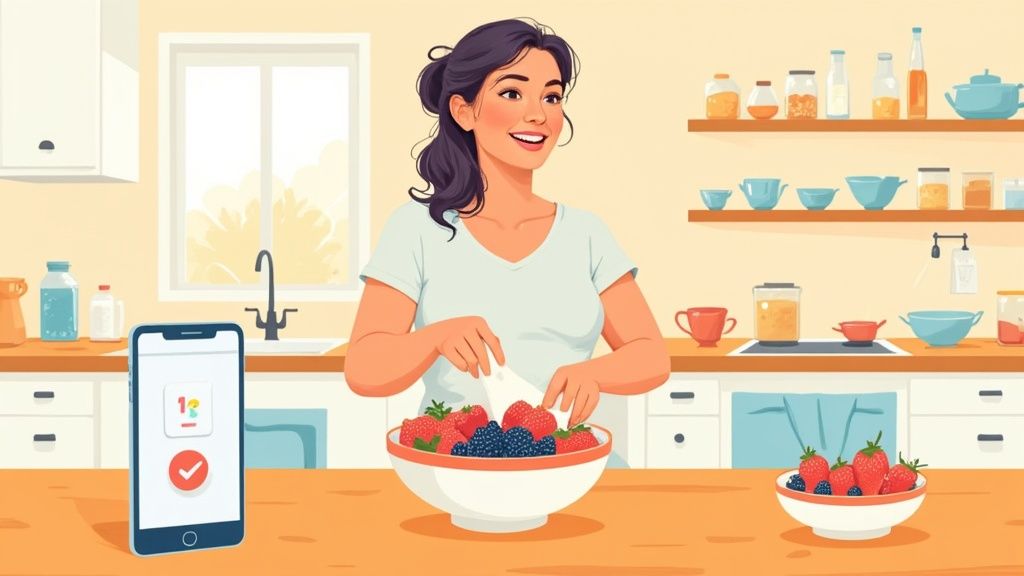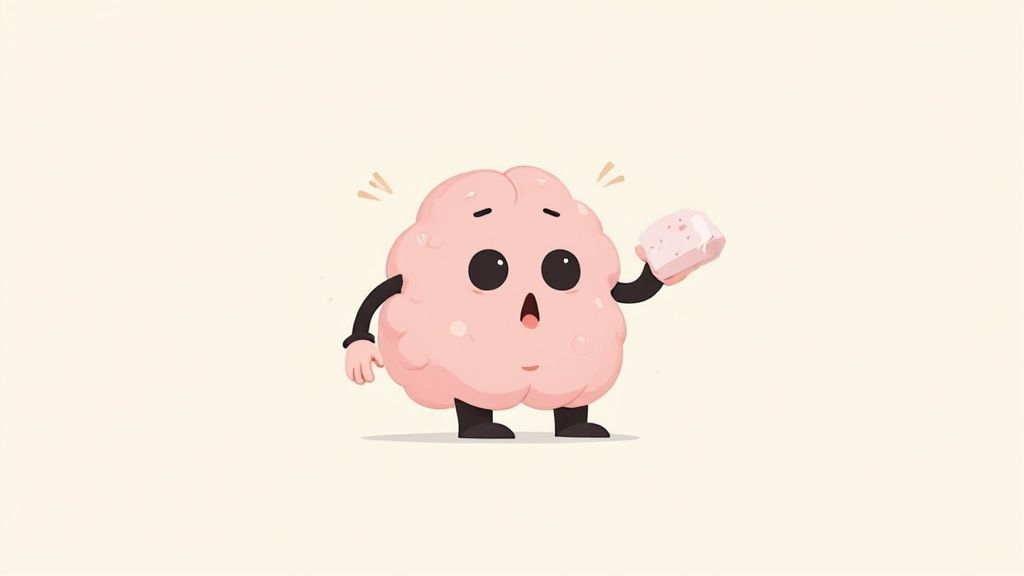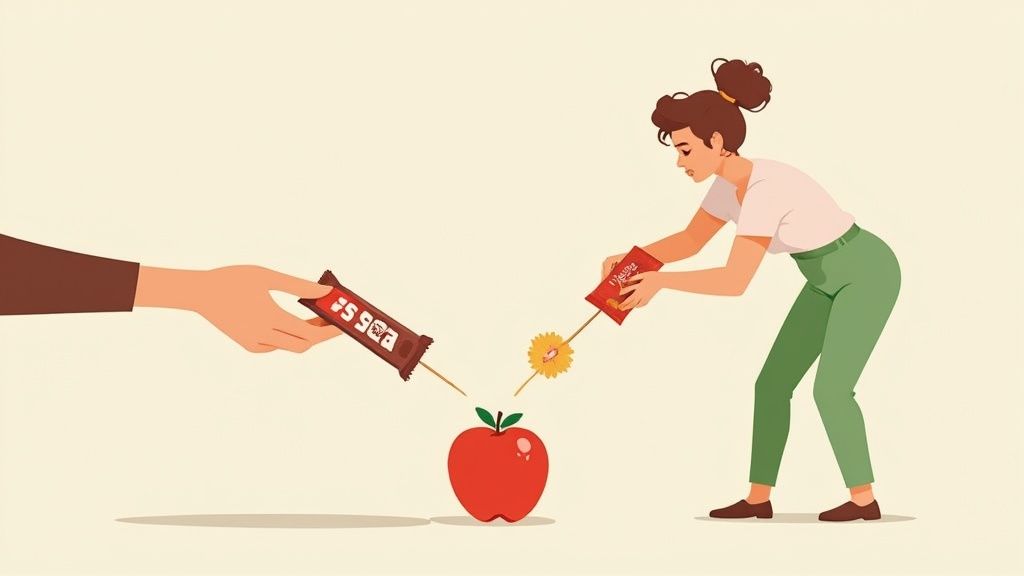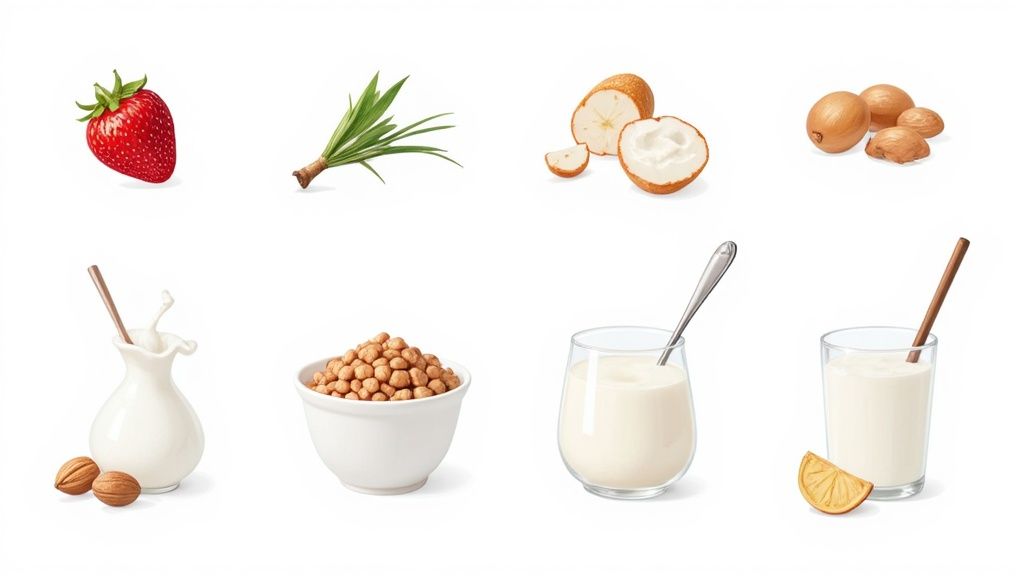Overcome Sugar Addiction: Your Science-Backed Freedom Guide

Understanding What You're Really Fighting

Let's be real – ditching sugar isn't a simple swap of cookies for carrots. It's about getting to grips with the intense forces at work inside your brain and body. That afternoon slump that has you raiding the candy stash? That's not a willpower fail; it's a complex mix of hormones, neurotransmitters, and ingrained habits. Think of it like this: you're not battling a single craving, you're up against a whole system wired to reward you with pleasure.
This reward system runs on dopamine, the same chemical involved in other addictions. Sugar triggers a dopamine flood, creating a feeling of euphoria. This reinforces the desire for more sugar to recapture that rush. Over time, your brain gets used to this dopamine surge, needing even more sugar to get the same effect. That's why one square of chocolate often morphs into the whole bar. It's not about being “bad” at self-control, it’s about recognizing the biological reality of sugar’s hold on your brain.
And the food industry knows this. They expertly craft products loaded with sugar, salt, and fat to maximize this dopamine release, creating a cycle of craving and consumption. Think of those vibrant candy displays or the alluring smell of fresh-baked treats. These aren't accidents; they’re deliberate marketing tactics designed to tap into your brain’s reward system.
Public health campaigns face a tough fight against these powerful forces. In the United States, the average person consumes a whopping 126.4 grams of sugar daily, way over the recommended 25 grams. Even with growing awareness and efforts to cut back, many people struggle to make lasting changes. Market research shows that while many try to reduce sugar, relapse is common thanks to its addictive nature. Discover more insights on global sugar consumption. This underscores the importance of not just limiting sugar, but also understanding the science behind addiction to create real, effective strategies. Beating sugar cravings takes more than willpower; it needs a smart plan that tackles the root of these cravings and gives you the tools to break free.
To illustrate how easily sugar sneaks into our diets, let's look at the hidden sugar content in everyday foods. The table below compares seemingly healthy options with obviously sugary treats.
| Food Item | Serving Size | Sugar Content (grams) | Equivalent Teaspoons |
|---|---|---|---|
| Plain Yogurt (low-fat) | 1 cup | 17 | 4 |
| Granola Bar | 1 bar | 12 | 3 |
| Ketchup | 1 tablespoon | 4 | 1 |
| Canned Fruit (in syrup) | 1/2 cup | 19 | 4.75 |
| Soda | 12 oz can | 39 | 9.75 |
| Candy Bar | 1.5 oz | 22 | 5.5 |
As you can see, even foods we perceive as healthy can contain significant amounts of hidden sugar. This makes mindful eating and checking food labels essential in our fight against sugar. Understanding where sugar lurks is a powerful first step in taking control.
Setting Yourself Up For Actual Success
Before you even think about ditching all things sweet, let's talk about strategy. Kicking a sugar habit isn't about sheer willpower and battling constant cravings. It's about creating a real plan for success. The people I've seen truly succeed aren't just relying on grit; they’re building a support system around themselves and a mindset that makes sugar-free living feel, well, livable.
Shifting Your Perspective
One of the biggest roadblocks is thinking of quitting sugar as "punishment." We tell ourselves we can't have something, and of course, that makes it even more tempting. Try shifting your perspective. See it as a choice you're making for yourself, for your health, for your energy. Focus on the good stuff: better sleep, a more stable mood, and feeling less sluggish. Let those be your motivation. It’s not deprivation, it’s empowerment.
When I quit sugar, I definitely felt like I was missing out. But then I started paying attention to how much better I felt after meals. No more crashing, no more brain fog. That’s what kept me going. Honestly, it gets so much easier when you see it as a positive change, not a sacrifice.
Practical Sugar-Proofing
Building a support system is essential, and I don’t mean turning your kitchen into some kind of sugar-free fortress. It’s about making healthy choices the easy choices. For example, keep a bowl of fruit on the counter instead of that candy dish. When the afternoon slump hits, you’re way more likely to grab an apple if it’s right there.
Prepping healthy snacks ahead of time is another game-changer. Having pre-cut veggies and hummus ready to go makes it so much harder to justify reaching for that sugary processed snack.
Here's a quick peek at the wide world of sugar substitutes – it really shows you how many options are out there if you want to cut down: This Wikipedia entry breaks down all sorts of substitutes, both natural and artificial, so you can see how they stack up in terms of sweetness and potential health effects. Finding the right one for you can be a big help in managing your sugar intake.
Check out our beginner's guide on sugar detox for even more practical advice on prepping your mind and your surroundings for this change. Read also: Sugar detox for beginners It's also super important to have realistic expectations. You’ll probably have some withdrawal symptoms – headaches, irritability, those kinds of things. Knowing they’re temporary will help you ride them out instead of freaking out and diving headfirst into the cookie jar. Remember, this is a journey, not a race.
Finding Satisfying Alternatives That Actually Work
Let's be honest, kicking sugar to the curb isn't about giving up sweetness entirely. It's more about retraining your taste buds and finding enjoyable alternatives that won't send you on that addictive sugar rollercoaster. Forget the fake stuff and weird chemical concoctions. This is about real, whole foods that satisfy your sweet tooth and nourish your body.

This infographic really highlights the difference between the recommended daily sugar intake (30g), what the average person actually consumes (90g), and the resulting increased risk of diabetes (32%). Think about it: most people are eating three times the recommended amount of sugar! That's a huge reason why finding healthier alternatives is essential to breaking free from sugar's grip.
Exploring Natural Sweetness
One of the most effective ways I've found to ditch sugar is by slowly introducing my palate to natural sweetness. This means incorporating whole fruits like berries, apples, and bananas. They provide that satisfying sweetness without the nasty sugar crash. Plus, they're loaded with fiber, which keeps your blood sugar stable and keeps you feeling full and satisfied.
And here's a secret weapon: spices. Cinnamon, nutmeg, and cloves can add a surprising amount of warmth and sweetness to your meals and drinks without the blood sugar spike. Try adding them to your coffee, yogurt, or even savory dishes for an unexpected flavor boost.
Handling Real-World Situations
Okay, so what happens when you're not at home? Navigating coffee shops and restaurants can be a minefield. Here are a few tricks I've learned over the years that have helped me – and countless others – stay on track:
- Be Prepared: Before heading out to eat, take a peek at the menu online. Lots of restaurants post nutritional information these days, making it easier to plan ahead.
- Don't Be Afraid to Ask: Your server is there to help! Don't hesitate to ask about ingredients or if they can make modifications to a dish. Most restaurants are happy to accommodate special requests.
- Bring Your Own: If you're really not sure about the options, pack your own healthy snacks or sugar-free alternatives. This way, you'll have something to satisfy your cravings without giving in to temptation.
Social gatherings can also be tough. No one wants to be that person who’s picky about what they eat. But remember, your health is important. Politely decline sugary treats and explain your choices if you feel comfortable. You might even inspire others to make healthier choices, too!
To help you on your journey, I've put together a comparison guide for different sugar alternatives. It breaks down everything from taste and sweetness levels to potential health impacts and best uses. This will give you a solid starting point for experimenting and finding what works best for you.
Sugar Alternatives Comparison Guide Detailed comparison of natural and artificial sweeteners including taste, health impact, and best uses.
| Sweetener | Sweetness Level | Calories per Serving | Best Used For | Pros | Cons |
|---|---|---|---|---|---|
| Stevia | 200-300x sugar | 0 | Beverages, baking | Natural, zero-calorie | Can have a bitter aftertaste |
| Monk Fruit | 150-200x sugar | 0 | Beverages, desserts | Natural, zero-calorie | Can be expensive |
| Erythritol | 60-80% sugar | 0.24 per gram | Baking, desserts | Minimal aftertaste, low glycemic index | Can cause digestive upset in large quantities |
| Xylitol | Similar to sugar | 2.4 per gram | Chewing gum, candies | May improve dental health | Can cause digestive upset in large quantities |
| Honey | Slightly sweeter than sugar | 64 per tablespoon | Tea, desserts | Natural, contains antioxidants | High in calories and fructose |
| Maple Syrup | Less sweet than sugar | 52 per tablespoon | Pancakes, oatmeal | Natural, contains some minerals | High in calories |
This table gives you a quick overview of some popular options. Remember, everyone’s different. What works for one person might not work for another. The key is to experiment and find what you enjoy and what helps you stay on track with your sugar-free goals.
Handling Cravings When They Hit Hard

That 3 PM energy dip or the sudden urge to demolish a pint of ice cream after a stressful argument? We've all been there. Kicking a sugar habit isn't about never feeling a craving; it's about knowing what to do when your willpower takes a nosedive. So let's talk practical strategies, the kind that actually work in the real world.
Deciphering Your Cravings
The first trick is learning to spot the difference between a physical craving and an emotional trigger. A physical craving might just be your body saying, "Hey, I need some fuel!" In that case, a piece of fruit or some nuts can give you sustained energy without the sugar rollercoaster.
But emotional triggers? Those are often tied to stress, boredom, or sadness. Figuring out that connection is key. Instead of hitting the candy jar when you're stressed, maybe try a quick walk, a chat with a friend, or something relaxing.
For example, I used to find myself craving chocolate every afternoon. Eventually, I realized it wasn't actual hunger—it was a sign I needed a break from work. Once I started taking short walks in the afternoon, the chocolate cravings practically vanished.
Your Emergency Toolkit
When a craving hits hard, having a go-to plan can be a game-changer. Think of it as your emergency toolkit:
- StopSugar's Panic Button: The panic button in the StopSugar app is your instant lifeline. It offers distractions and alternatives tailored to you, helping break the craving cycle right then and there.
- Mindful Breathing: Seriously, just a few deep breaths can center you and disrupt that automatic urge to reach for sugar.
- Hydration: Sometimes we confuse thirst with hunger or a sugar craving. A glass of water can often do the trick.
These simple but powerful techniques interrupt that automatic sugar grab and give you a moment to choose differently.
Global efforts to fight sugar addiction have had ups and downs. Even with more awareness and sugar taxes in over 50 countries, worldwide sugar consumption is still expected to grow. The UK, for instance, saw a 10% drop in sugar from soft drinks after their sugar tax, but total consumption only dipped by 1-2%. This just shows how tough it is and why having your own strategies is so important. Want to know more about these global trends? Discover more insights about the global sugar market. You can also find some useful tips in our guide on how to stop sugar cravings. Check out our guide on how to stop sugar cravings. Remember, setbacks happen. Don't beat yourself up if you slip up. Just get back on track. Acknowledge it, learn from it, and keep moving forward.
Creating Habits That Feel Natural

Quitting sugar isn’t about sheer willpower; it’s about creating habits that become second nature. Imagine reaching a point where cravings are a distant memory. That's the real victory. This section dives into the long-term strategies and mindset shifts that help you stay sugar-free, even when life gets crazy.
From Restriction to Abundance
One of the biggest changes is shifting your perspective from restriction to abundance. Constantly denying yourself something leads to feelings of deprivation. Instead, concentrate on the amazing foods you can enjoy. Fill your plate with vibrant fruits, vegetables, and wholesome meals that satisfy your cravings and nourish your body.
For example, when I initially quit sugar, I fixated on all the things I "couldn't" have. Then, I began exploring new recipes and discovered a world of flavors I’d never experienced. Suddenly, it wasn’t about deprivation; it was about exciting culinary adventures.
Building Flexibility
Life throws curveballs. There will be travel, illnesses, birthdays – situations where you might encounter sugary temptations. It’s crucial to build flexibility into your approach so you can navigate these without derailing your progress. Talk to others who have successfully maintained a healthy relationship with sugar, and you'll discover they've learned how to handle these real-world scenarios.
Personally, I’ve learned it's okay to indulge occasionally. A small slice of birthday cake or a special dessert during a trip isn't a catastrophe. The key is mindful enjoyment, followed by a return to your regular habits.
Personalized Strategies
One-size-fits-all doesn't work when it comes to quitting sugar. A single person faces different challenges than someone managing family meals and social events. Factor your personality and lifestyle into your strategies. Are you a planner? Meal prep is your best friend. More spontaneous? Keep StopSugar’s alternatives engine handy for suggestions on the fly.
StopSugar’s daily check-ins help you recognize patterns in your cravings and moods. This self-awareness is incredibly powerful. You’ll begin to connect the dots between your emotions, your environment, and your sugar cravings, allowing you to develop personalized coping mechanisms. And when those intense cravings strike? StopSugar's panic button provides instant distractions and alternatives, helping you break the craving cycle before it takes over. This combination of personalized strategies and immediate support is the secret to building long-lasting, sustainable habits.
When Things Don't Go According to Plan
Let's be real, kicking a sugar habit isn't always rainbows and butterflies. It can be a bumpy ride, even when you're armed with the best intentions and strategies. This section dives into those common challenges and offers some practical, honest solutions. Knowing how to handle setbacks is key to winning this long-term game.
Understanding the Rollercoaster
First things first, everyone's experience is unique. Some people breeze through the initial phase with minimal discomfort. Others wrestle with intense withdrawal symptoms like headaches, irritability, and powerful cravings. This isn't a willpower issue; it often comes down to your individual biochemistry and how deeply rooted that sugar habit is. If you're curious to learn more, check out this post on sugar withdrawal symptoms.
Plateaus and Progress Stalls
So, what happens when your initial progress hits a wall? Don't freak out. Plateaus are totally normal. Our bodies are masters of adaptation, and what worked at the beginning might need a little tweaking. This is where StopSugar's daily check-ins become super helpful. By tracking your sugar intake and mood, you can spot patterns and triggers that might be slowing you down. Maybe you'll notice that stress or a poor night's sleep always seems to precede a sugar binge. That awareness empowers you to proactively adjust your approach.
Dealing With Unsupportive Environments
Another common hurdle? Navigating friends and family who just don't get your sugar-free journey. They might tempt you with treats, question your choices, or even unintentionally sabotage your efforts. Honest communication is the best strategy. Explain why you're quitting sugar and how they can support you. Sometimes, simply setting boundaries and politely declining those sugary offerings is all it takes.
Bouncing Back From Slip-Ups
Now, let's talk about those inevitable slip-ups. They happen. We're all human. The biggest mistake is letting one slip-up snowball into a full-blown sugar binge fueled by guilt and shame. Instead, acknowledge the slip-up, figure out what triggered it, and use StopSugar’s panic button for immediate support and alternative suggestions. Remember, recovery isn't a straight line. It's about learning from setbacks and getting right back on track without losing sight of your goals.
Recognizing When You Need More Support
Sometimes, conquering sugar addiction requires more than going it alone. If you're seriously struggling with withdrawal, facing overwhelming cravings, or feeling like you're constantly fighting sugar's pull, consider seeking professional help. A registered dietitian or therapist specializing in addiction can offer personalized guidance and help you build a sustainable plan.
Key Takeaways
Kicking a sugar habit is a deeply personal journey. What works for one person might not work for another. This section boils down the most important parts of this guide, giving you a practical plan you can start using today. Remember, this isn't about some unattainable ideal of perfection. It's about building a healthier, more sustainable relationship with food—one that puts you in control.
Setting Meaningful Goals
Forget about drastic overnight changes. Real, lasting change happens gradually. Begin by pinpointing your biggest sugar traps. Is it that daily soda? The after-dinner dessert? Once you know what you're up against, you can start finding healthier substitutes. Think sparkling water with a squeeze of lemon instead of soda, or a bowl of berries with some Greek yogurt instead of that sugary dessert. These small victories build momentum and lay the groundwork for long-term change.
Remember, progress, not perfection, is the name of the game here.
Recognizing Warning Signs
StopSugar’s daily check-ins are incredibly helpful. By keeping track of your sugar intake and your mood, you'll start to see patterns you might not have noticed before. Do you find yourself craving sweets when you're stressed? That's a valuable piece of information! Next time stress hits, try going for a walk or taking some deep breaths before you grab the candy. And when those cravings hit hard, the StopSugar panic button offers immediate support, with distractions and alternatives specifically designed for your needs.
It's about understanding why you reach for sugar and finding different ways to cope.
Celebrating Progress, Not Perfection
This isn't a straight-line journey. There will be times you slip up. The important thing is to see those moments as learning opportunities, not as failures. StopSugar's alternatives engine is a fantastic tool for discovering new ways to satisfy those sweet cravings without throwing all your progress out the window. Did you enjoy a piece of birthday cake? Fantastic! Savor it mindfully, and get right back on track the next day. It’s all about building sustainable habits, not beating yourself up over the occasional treat.
Enjoy those treats, but don't let them derail you!
Realistic Expectations and Indicators
Breaking a sugar addiction takes time, so be patient with yourself. Real success isn’t about the number on the scale. It’s about how you feel. More energy, steadier moods, better sleep – those are the signs that truly matter. Remember those initial withdrawal symptoms? The headaches, the irritability? They're temporary. Knowing what to expect will help you power through. And if you’re really struggling, don’t hesitate to reach out to a professional. A registered dietitian or a therapist can provide personalized guidance tailored to your specific needs. This journey is about empowering yourself for long-term health and well-being, not short-term deprivation. You’ve got this!